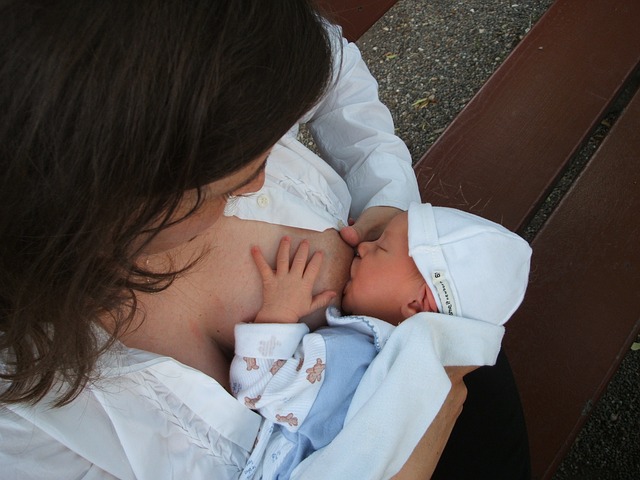How do you get your baby to latch on properly?
We speak to Ms Jophia Bok, Staff Nurse & Lactation Nurse, from www.breastmilk.com.sg.

Latching your baby will be a better choice, especially from after delivery to 3-6 months postnatal, says Ms Bok.
She outlines three main benefits of latching:
1. Your baby will learn
The baby will learn patience and perseverance through latching. As baby latches and under mummy’s guidance, they will learn that milk will naturally flow (and achieve let-down) if they latch correctly and keep sucking.
2. Your body will adjust
Mummy’s physical body responds positively and effectively when there is constant skin-to-skin contact with her own baby. Your body will slowly adjust to the amount of breastmilk being produced that is sufficient for your growing baby. It is possible for mummy to achieve 2-3 let-down in one breastfeeding session.
3. Have blocked ducts? Latch more
When mummy is having blocked ducts or engorgement, the first line of action is to encourage her baby to latch on more often. Baby’s proper latching will form a very good suction for the mummy’s problem breast. As the baby is sucking, mummy should do a gentle massage on the blocked and painful area on her breast. This is to aid the thickened breastmilk to be broken up and pushed out of the nipple along the duct.
How To Get Baby To Latch On Properly

Ms Bok encourages new mummies to try to remember not to panic and fuss around the baby when they cry for milk. This is because your baby will naturally amplify your emotions by crying more and more intensively. So, it is a good habit to keep calm.
“Gently acknowledge baby’s need for milk and reassure baby that you are preparing yourself for your baby to latch on. As you are speaking to your baby, your actions of preparation must be quick,” shares Ms Bok.
Ms Bok shares the following tips to get your baby to latch on properly:
- If you are still getting used to breastfeeding, have someone else bring the baby to you when you are in your comfortable position and waiting to receive baby.
- You can gently massage the breast that you are going to let your baby latch on.
- Encourage your baby to open their mouth by showing your own big mouth to baby.
- Position baby in the desired position. Make sure that baby has a good and straight head-body alignment.
- Use your nipple to touch baby’s upper lips (to stimulate oral reflex), and if baby is hungry, they will open their mouth.
- As baby’s mouth open wide, with tongue flat down, immediately cup baby’s mouth over your nipple with only the rim of your areola (brown portion of the nipple) showing outside your baby’s mouth. Their lips should be flanged outwards. This is a good latch.
As baby is sucking, listen and watch for poor latch indicators like:
- Clicking sounds from baby’s mouth
- Sucking of air into the mouth
- Baby’s mouth is sucking at the tip of the nipple
- Baby’s cheeks have a large ‘dimple’ as they are sucking
- You feel pain
Mistakes To Avoid While Latching Baby

Ms Bok highlights four main pitfalls to avoid during latching:
#1 Do not latch baby when the baby does not open their mouth wide.
#2 Do not continue the latch if you feel pain throughout the breastfeeding session.
You will develop a bad sore or bleeding nipples. Always unlatch with the proper technique and re-latch the baby again.
#3 Try not to latch baby with nipple shields if you have not tried direct latching before.
Usage of nipple shields may lead to other complications (e.g. blocked ducts in the breast around the rim of the shield) for most mummies.
#4 Do not disrupt your baby’s breastfeeding session if they are latching and drinking well.
It will break the momentum of the baby and baby may not be willing to continue feeding till sufficient.
Should I latch when I have breast complications such as cracked nipples, mastitis, blocked ducts or engorgement?
Breastfeeding can still be continued when mummy is experiencing such issues.
Latch as per normal, Ms Bok states. She provides pointers on how to tide over the pain.
For cracked, sore, bleeding nipples:
- Ensure that the latch is proper in babies. “It will be very painful during the first minute of latching and as the baby is sucking. However, the pain will not last throughout the breastfeeding session if the latch is proper,” she assures.
- After each breastfeeding session, remember to use a clean dampened cloth to wipe the nipples.
- Then squeeze a little breastmilk and smear it over the nipples. Air dry them. You can also smear nipple cream sparingly after air drying your nipples.
- You can cup a nipple shield over the problem nipples to prevent clothing from coming in contact with the sore nipples.
For breast infection or mastitis:
- If your breastmilk shows streaks of pus, stop feeding on that breast and seek medical support.
- Express milk every 2 hourly on the problem breast and discard the milk.
Ms Bok reiterates the rhetoric of early intervention being the best way to increase the chances of successful breastfeeding. “If you are in doubt, always approach a lactation consultant or a friendly breastfeeding doctor for advice.”
By Rachel Lim.
This article was first published in The New Age Parents e-magazine.
* * * * *
Like what you see here? Get parenting tips and stories straight to your inbox! Join our mailing list here.
Want to be heard 👂 and seen 👀 by over 100,000 parents in Singapore? We can help! Leave your contact here and we’ll be in touch.






















































